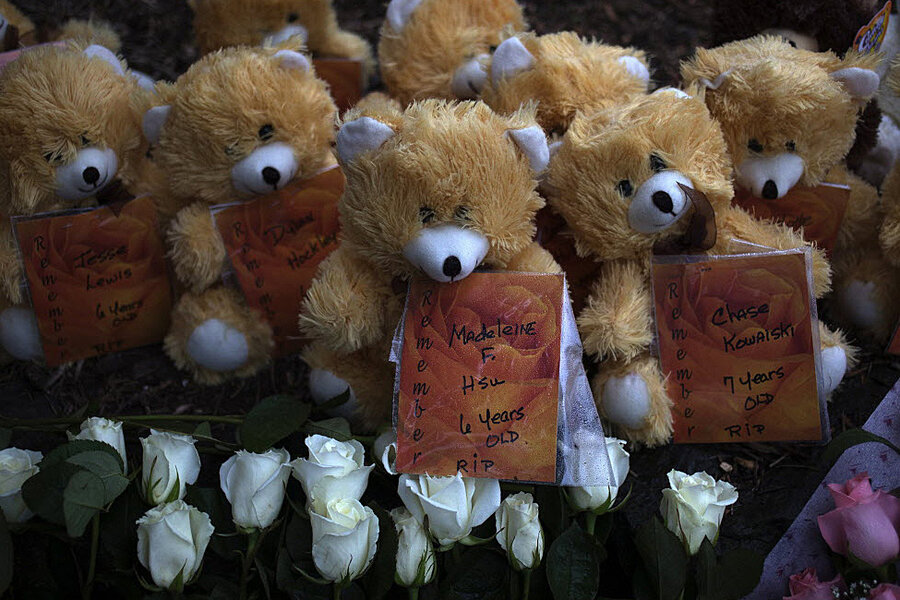Teddy bears to ease the pain: from Newtown to the world
Loading...
As residents of Newtown, Conn. privately observe the one-year anniversary of Sandy Hook Elementary's devastating school shooting, an immense and unbidden migration of stuffed animals that descended upon the grieving town last year has been dispersed, paying forward the outpouring of sympathy to other communities in pain.
News of the tragedy, broadcast internationally, moved people to donate more than $11 million and approximately 72,000 stuffed animals to Newtown, some of which were sent to specific families.
But most donated toys were simply addressed to "Newtown, CT," and the influx quickly exceeded the small town's capacity for bears, some of them larger than the first graders they were sent to comfort. Within a week, the town asked the public to stop sending stuffed animals, but they kept arriving.
"They came in semis," says Carole Ross, Newtown's Human Resources administrator. "We appreciated the love that was coming in, but it was overwhelming."
Initially, Newtown Selectwoman Patricia Llodra announced plans to turn all non-organic donations, including surplus teddy bears, into bricks and building materials for an official tribute, according to a New York Times report.
But the families affected by the shooting first gave all Sandy Hook Elementary students their pick. And then anyone in Newtown. Finally they decided to forward the bears to any needy community they could think of. So they identified humanitarian groups working with towns and cities as far away as Haiti, Afghanistan, and Jamaica, and sent the Newtown bears packing.
America Responds With Love (ARWL), a nonprofit organization that connects US communities in crisis with needed goods, wound up loading 21 pallets of stuffed animals into a donated semi-trailer in late March. They were driven down the East Coast, where they found their ways into reading programs, police cruisers, and communities beset by their own disasters.
Richard McDonough, the president of ARWL, knew of police departments that deployed stuffed animals in cruisers to make violent-crime investigations less traumatic for children. The Camden, N.J., department runs one such program, called "Toys for Tears," and its chaplain, Msgr. Michael T. Mannion, helped get a squad of Newtown bears to where they were needed.
"It's such a traumatic moment for a child," says Monsignor Mannion. "To be comforted at that moment by an officer who first expresses a human, compassionate gesture, before the professional task has to be addressed, is a very consoling and productive methodology."
Lt. Jon Clark of the Horsham, Penn., police department, which also received 50 Newtown teddies, says they go a long way toward helping "a little person" cope with bad moments. "Lets say a mom comes in because she wants to file a [Protection from Abuse order], and she's got two little kids, and you can tell they're upset, in a strange police station," he says. "If we can get that tragic look off their face and turn it into a smile, if only for a couple minutes, it makes it better for both of us."
The monsignor, who also serves as chaplain to the FBI's Philadelphia division, connected the bureau to the bear stream as well.
"He had bears, and I had a place to bring them," says Elisa Lehman, an FBI victim specialist who works with the Philadelphia Children's Alliance. Now, all victims of child abuse who come to the center for assessment by law enforcement are invited to take a teddy bear away from the ordeal.
"If you can think about talking to a stranger about your worst experiences, it's a difficult time, it's exhausting," she says. But a stuffed animal "can put a smile on their face, and it can shift their focus."
"The federal government does not have a budget for teddy bears," points out ARWL’s Mr. McDonough.
His organization also funneled bears to a summer reading program in Plainfield, N.J., and to Aurora, Colo., site of the fatal 2012 movie theater shooting spree. Aurora distributed 100 stuffed animals among 11 nonprofit organizations during the one-year commemoration of its tragedy, and it donated another 100 to Cañon City, Colo., a town two hours away whose tourist industry had been crushed by a recent wildfire.
ARWL has worked with many communities rebounding from disasters, and McDonough says that deluges of anonymous teddy bears are common responses to tragedies involving children. But, he adds, he had never before seen anything approaching a 72,000-teddy-bear response.
"There was no logical reason anybody at that time could understand why [the shooting] happened. And I think they saw the faces of horror,” he says. “People feel the need to do something. They don't know what [it is] that’s truly needed, but they do something that they think would be useful. Teddy bears are one of those things. The problem is, it creates a dilemma for the community as it deals with its main issue."
A small number of the teddy bears did stay in Newtown, and some were incorporated into shrines. Anthropologist Sylvia Grider, a researcher at Texas A&M University, has described the symbolic importance of modern shrines for grieving communities: “For many people, placing a memento at a shrine is an act as sacred and comforting as lighting a candle at a church altar,” she writes. “The shrines are a metaphoric threshold which represents the end of numbness and the beginning of the ability to take action.”
Ms. Ross, the Newtown Human Resources administrator, said Newtown families reeling from their own loss and trauma found some consolation in seeing the bears off.
"That we were giving to other children who didn't get a Christmas" softened the pain, she said.








